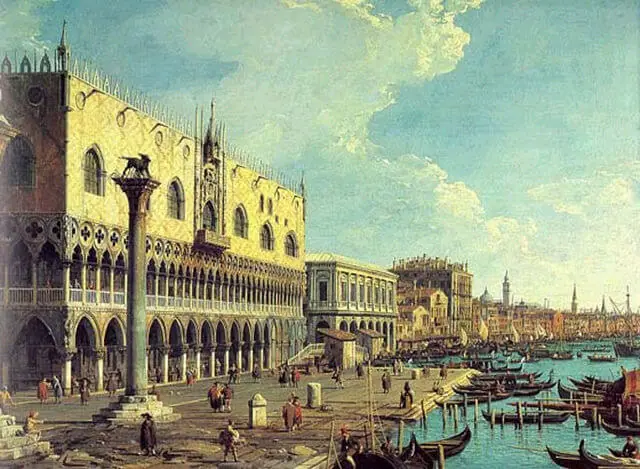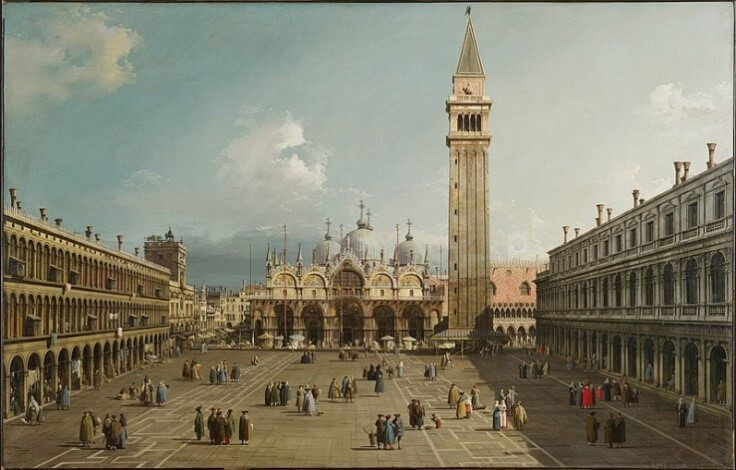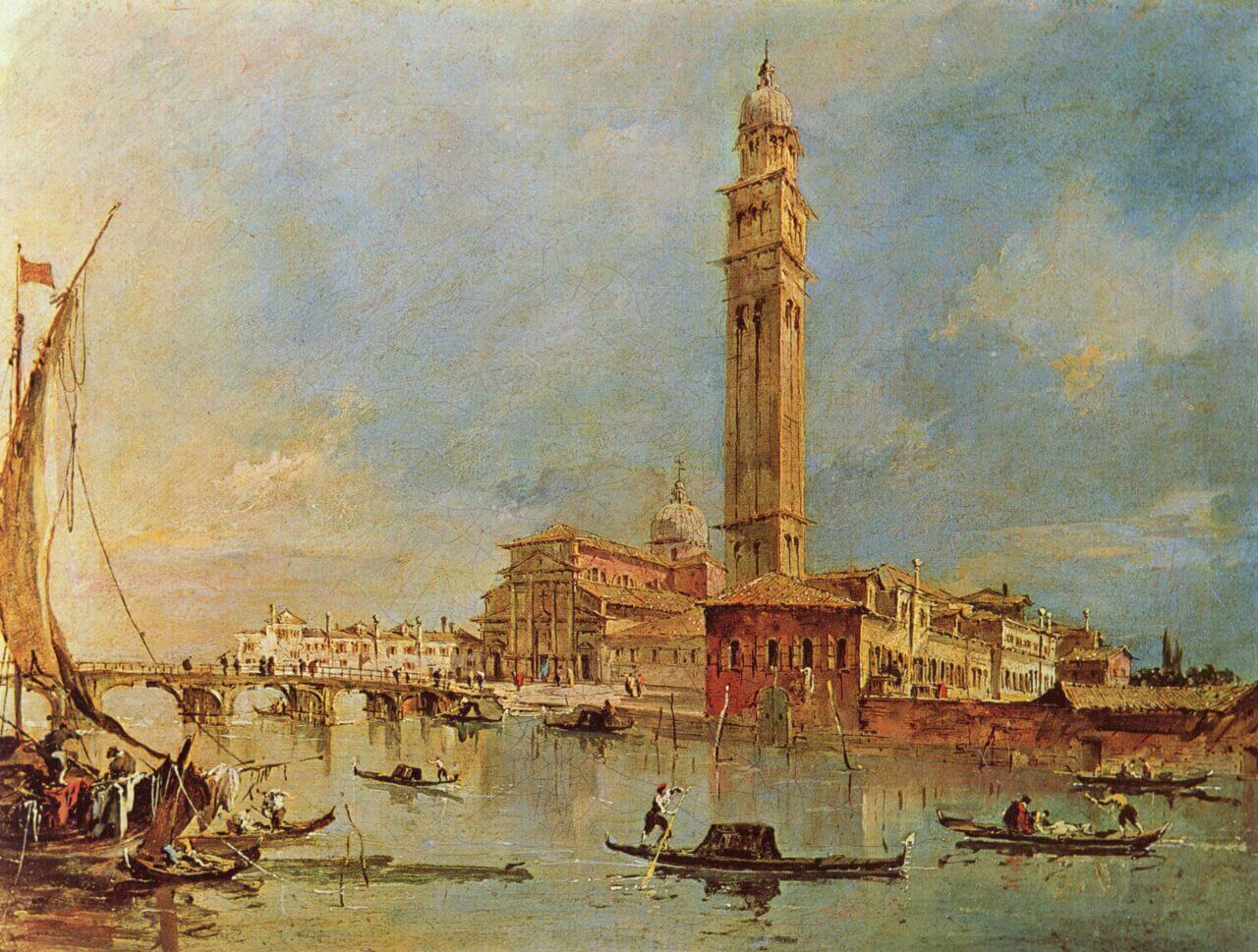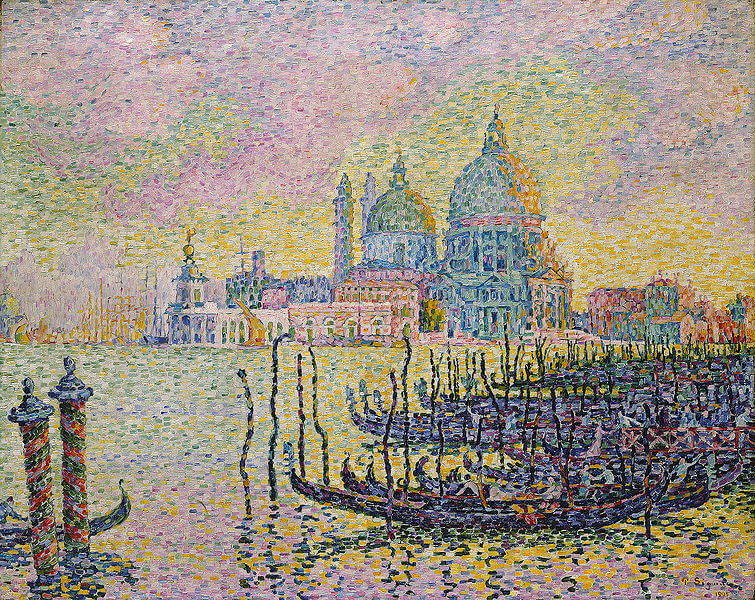Giovanni Antonio Canal, called Canaletto, Piazza San Marco, c. 1730
Harvard University Art Museum, Cambridge
Giovanni Antonio Canal, called Canaletto, Piazza San Marco, c. 1730-34
Our list must surely begin with a painting by Canaletto (1697 – 1768), whose reputation is arguably synonymous with that of Venice. Canaletto was born in Venice, so it seems fitting that such a large part of his oeuvre is dedicated to depictions of his native city, executed first for local patrons and later, as he gained notoriety, for Grand Tourists of the 18th century. Canaletto was one of the great vedutisti – painters of highly detailed views (or vedute) – and thus benefitted from the increasing number of visitors and tourists that the city attracted. Through agents (firstly Owen Swiny and then Joseph Smith), many of his topographical views were sold to Englishmen, which accounts for the number of works now in our museums and public galleries.
This painting, Piazza San Marco, dates from c. 1730-34, making it one of Canaletto’s earlier, more desirable works; as demand for his paintings increased, Canaletto produced more and more works with the involvement of workshop assistants. The clear blue sky, against which the Basilica and Campanile are sharply silhouetted, is an example of the luminosity typically found in Canaletto’s vedute, whilst the figures, who are gathered in groups and dotted around the square, bring a sense of liveliness and theatricality to the stage-like scenery of the city.
Francesco Guardi, Vedute dell’Isola di San Pietro di Castello, second half of 18th century, Calouste Gulbenkian Museum, Lisbon
Francesco Guardi, Vedute dell’Isola di San Pietro di Castello,
second half of 18th century
The name Francesco Guardi (1712 – 1793) is often one to follow that of Canaletto, and for good reason, as it was he who, alongside Canaletto, helped to develop the ‘view painting’ tradition in Venice. He is considered by many to be among the last great painters of the Venetian School, with whom he had more than simply creative connections; his father, Domenico, was also an artist, and, in 1719, his sister married fellow painter Giovanni Battista Tiepolo.
Perhaps inspired by the vibrant work of his brother-in-law Tiepolo, Guardi – having previously taken stylistic inspiration from Canaletto – painted with greater freedom and vivacity as his career progressed. Indeed, this painting entitled Vedute dell’Isola di San Pietro di Castello, when compared with the example by Canaletto, emphasises this through a distinct contrast. Guardi’s use of blue in differing shades and his almost Impressionist mastery of reflections gives his work a certain fluidity that is entirely fitting for the subject matter. His buildings too – most notably the campanile – are rendered in hues of red, orange and yellow so that they appear to glow, a reminder of the warm Adriatic climate. When it comes to creating atmosphere, no one does it quite like Guardi.
J. M. W. Turner, Venice from the Porch of Madonna della Salute, 1835,
Metropolitan Museum of Art, New York
J.M.W. Turner, Venice from the Porch of Madonna della Salute, 1835
Even within an artistic career as prolific and illustrious as that of J.M.W. Turner (1775 – 1851), it is his images of Venice that are perhaps his most recognisable and magical. Turner made three trips to Venice, visiting first in 1819 at the age of 44, and then again in 1833 and 1840. Already a mature artist prior to his first sojourn there, he would have known something of the city, having no doubt seen the work of Canaletto, Guardi and other painters of Venice before him. He would also have been aware of the city through literary works by the likes of Lord Byron (1788 – 1824), who celebrated it’s unique beauty in poems like his ‘Ode on Venice’ or ‘Childe Harold’s Pilgrimage’.
In this work, Venice from the Porch of Madonna della Salute, Turner has certainly captured the city’s serenity, from which it takes its nickname, ‘La Serenissima’. Whilst the waters of the Grand Canal today are in constant motion – stirred up by an ever-growing fleet of private boats, taxis and waterbuses – this painting offers a considerably calmer depiction of the city’s main thoroughfare. With only the odd ripple marking an otherwise glassy surface, the boundaries between sea and sky, boat and building, indeed between every object and its reflection are blurred, giving the cityscape a sense of mystery and wonder. Turner has in this way made full use of the very stuff on which Venice is founded – or rather, floated.
Paul Signac, Entrance to the Grand Canal, Venice, 1905,
Toledo Museum of Art
Paul Signac, Entrance to the Grand Canal, Venice, 1905
This work by Paul Signac (1863 – 1935) is perhaps a more vibrant, yet equally soft, approach to depicting the city of Venice. Signac, alongside Georges Seurat (1859 – 1891) and Henri-Edmond Cross (1856 – 1910), was one of the main advocates of the ‘Pointillist’ technique, which saw artists placing dots of pure pigment directly onto the canvas. Rather than blending colours on a palette prior to application, artists who employ this technique rely upon optical mixing (the mixing of colours through the eyes of the viewer). Having spent a great deal of time in Saint-Tropez painting the Mediterranean, Signac had largely mastered his technique when he came to Venice in April 1904 and so was able to whole-heartedly embrace the city’s aqueous nature.
This painting shows the entrance to the Grand Canal from the East, almost as though the viewer is standing in the Piazzetta di San Marco. From behind a row of gondolas and through the haze, we see the domes of Santa Maria della Salute rising into the sky. Signac’s style lends itself perfectly to such an atmosphere; rather than depicting the buildings with solid outlines, he uses thickly-applied daubs and dashes that make them somewhat indistinct as though they are way off in the distance and dimly lit by a low evening sun. Similarly, the Grand Canal is made up of a series of short horizontal strokes, which gives the impression of continuous movement, whilst the combination of pigments (particularly the dashes of yellow) create the effect of light moving across its surface.
Claude Monet, Grand Canal, Venice, 1908,
Museum of Fine Arts, Boston
Claude Monet, Grand Canal, Venice, 1908
Our list would not be complete without the inclusion of a work by perhaps the most well-known Impressionist, Claude Monet (1840 – 1926). It was his work entitled Impression, Sunrise from 1872, a study of the port of Le Havre, that led to the movement’s name – a composition similar in some ways to this one. Monet’s fascination with water and the play of light upon its surface is well-documented; he famously constructed a waterlily pond at his home in Giverny, beginning in 1893, and painted it right up until his death in 1926. It is not entirely surprising, therefore, that Venice – ‘the city of water’ – also appealed to him.
Much like Turner, Monet came to the city later in his career, visiting just once in 1908 at the invitation of the society hostess Mrs Mary Hunter, whom he had met in London. He completed 37 paintings during this trip (including a series of 6 canvases depicting the present view), each of which is characterised by his late, loose style. In an equally colourful approach to that of Signac, Monet has used a mix of blues, greens and pinks to add depth to the water, over which lighter brushstrokes of yellow have been laid down to mimic the effect of dappled light. The result is surely evidence of a master at work.







